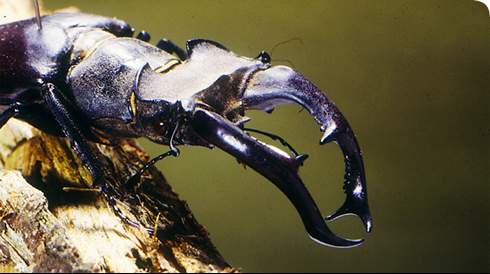Lucanus cervus (stag beetle)
Lucanus cervus the stag beetle is Britain’s largest known terrestrial beetle.
This magnificent beetle, famed for its antler-like mouthparts and its wrestling style of combat in the competition for a mate, make it a charismatic and emblematic creature of our times.
However, it is most commonly known for its rapid population distribution decline in the last 40 years. Habitat loss and landscape fragmentation and in turn the loss of dead wood habitats have directly contributed to this fact. Other factors such as road-kill and predation by common predators such as foxes, cats, and magpies have also impacted on its decline.
In many European countries as well as the UK, the stag beetle has protected status. It is listed on Annex II of the EC Habitats Directive and Schedule 5 of the Wildlife and countryside Act 1981. It is also a UK Biodiversity Action Plan species (BAP).
Species detail
-

Biology
The stag beetle's life cycle, is a complete metamorphosis and can take between 4-6 years. Fully grown adults emerge in the spring with the males emerging first. Find out more about the life cycle of the stag beetle.
-

Larval development
Larval development is so protracted due to the lack of nourishment gained from the larval foodstuff. Adult size differentiation may be dependent on the food available to the larval stage.
-

Behaviour
The adult males are seen on the wing from May to August, when they actively fly about looking for females, especially on warm summer evenings. Adults usually only live for a few weeks, their sole adult existence is to mate. Discover more about the behaviour of the stag beetle.
-

Distribution and habitat
The stag beetle has a predominantly south to southeast distribution in the UK. It is locally common in the Thames valley and surrounding areas as well as the Severn Valley and parts of the southwest coast. Find out more.
-

Conservation
Decaying dead wood is an essential component of this beetle’s life history. Have a look at the natural environment around you and see if it can be improved for harbouring insects, particularly the stag beetle. Learn more about what you can do to help the stag beetle.
-

References
Get more reference material for the stag beetle.

